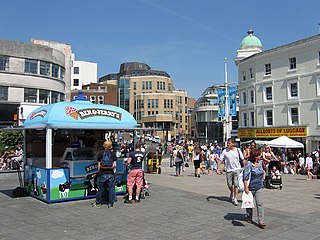
Brighton and Hove is a city and unitary authority area, ceremonially in East Sussex, England. There are multiple villages alongside the seaside resorts of Brighton and Hove in the district. It is administered by Brighton and Hove City Council, which is currently under Labour majority control.

Worthing is a seaside town and borough in West Sussex, England, at the foot of the South Downs, 11 miles (18 km) west of Brighton, and 18 miles (29 km) east of Chichester. With a population of 113,094 and an area of 12.5 square miles (32.4 km2), the borough is the second largest component of the Brighton and Hove built-up area, the 15th most populous urban area in the United Kingdom. Northern parts of the borough, including the Worthing Downland Estate, form part of the South Downs National Park. In 2019, the Art Deco Worthing Pier was dubbed the best in Britain.

Angmering is a village and civil parish between Littlehampton and Worthing in West Sussex on the southern edge of the South Downs National Park, England. About two-thirds of the parish fall within the park. It is 1.5 miles (2.4 km) north of the English Channel, and Worthing and Littlehampton are 3.5 miles (5.6 km) to the east and west respectively. It has been inhabited since the Bronze Age and there are the remains of a Roman Villa and bath house.

Goring-by-Sea, commonly referred to simply as Goring, is a neighbourhood of Worthing and former civil parish, now in Worthing district in West Sussex, England. It lies west of West Worthing, about 2.5 miles (4 km) west of Worthing town centre. Historically in Sussex, in the rape of Arundel, Goring has been part of the borough of Worthing since 1929.
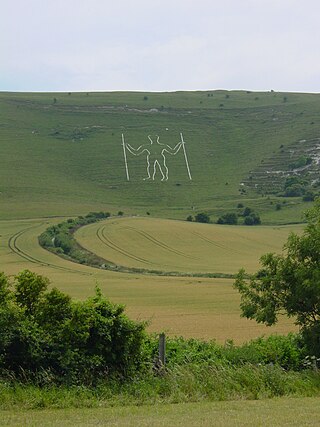
Long Man is a civil parish in the Wealden District of East Sussex, England, which includes the villages of Wilmington, Milton Street and Folkington. The parish is named after the Long Man of Wilmington, a 69.2-metre (227 ft) chalk figure in the parish.
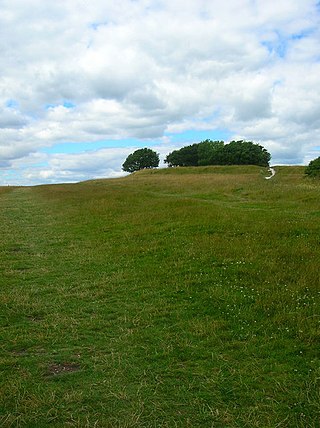
Highdown Hill is a hill in the South Downs, with a height of 81 metres (266 ft). The summit of the hill and its western slopes lie in the parish of Ferring in the Arun district, while its eastern slopes lie in the borough of Worthing. It is a popular spot for picnickers, dog-walkers and horse riders. It overlooks Littlehampton, Angmering, Ferring and Worthing with views as far east as the Seven Sisters and west to the Isle of Wight.
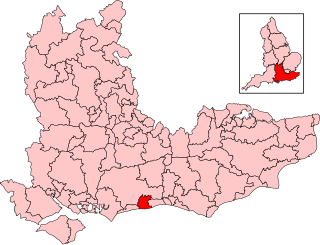
Worthing West is a constituency represented in the House of Commons of the UK Parliament since 2024 by Beccy Cooper of the Labour Party. She defeated the long serving incumbent Sir Peter Bottomley, a Conservative who was the Father of the House of Commons from 2019.
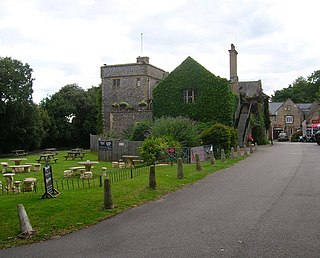
Sterns was a nightclub located at Highdown Towers on Highdown Hill in Worthing, West Sussex. It was situated off the A259 road just north of Ferring on the South Downs. It became known as a major centre of UK rave culture in the south of England during the late 1980s and early 1990s. It was a rare example of an early UK club boasting 4 separate rooms with DJs playing house, breakbeat hardcore, jungle music, techno, progressive house and hard house.
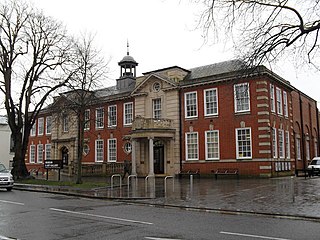
Worthing Museum and Art Gallery is in the centre of Worthing near the grade II* listed St Paul's. The building, which celebrated its centenary in 2008, was originally designed to house the town's library as well as the museum, the library section being funded by Andrew Carnegie. It is the largest museum in West Sussex.
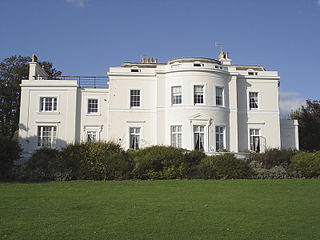
Beach House in Worthing, England is a Regency beach-side villa, built in 1820 to designs by John Rebecca. It was originally known as Marino Mansion. It was built for a man named Robert Cary Elwes..

Tilgate Park is a large recreational park situated south of Tilgate, South-East Crawley.

Towner Eastbourne is an art gallery located in Eastbourne, East Sussex, on the south coast of England. In 2019, German artist Lothar Götz was chosen from a call out to design a mural for the building's exterior. Götz transformed the exterior walls of the gallery with his large-scale, colourful geometric artwork, Dance Diagonal.

Worthing is a large seaside town in Sussex, England in the United Kingdom. The history of the area begins in Prehistoric times and the present importance of the town dates from the 19th century.
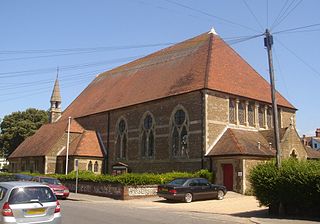
St George's Church is an Anglican church in the East Worthing area of the borough of Worthing, one of seven local government districts in the English county of West Sussex. Built in 1867–68 to serve new residential development in the southeast of the town, the Decorated Gothic-style structure was extended later in the 19th century, and expanded its reach further by founding three mission halls elsewhere in Worthing. English Heritage has listed it at Grade C for its architectural and historical importance.

Beach House Park is a formal garden in Worthing, a town and local government district in West Sussex, England. Opened by Worthing Borough Council in 1924, the 9.57-acre (3.87 ha) park has formal lawns and flowerbeds, bowling greens of international standard, and a war memorial commemorating war pigeons. A café in the grounds was destroyed by fire in 2009.
Worthing Rural District was a rural district in West Sussex, England from 1933 to 1974. It comprised an area to the north, west and east, but did not include the borough of Worthing. Its area encompassed the land in southern Sussex between the Rivers Adur and Arun, with the exception of Arundel, Littlehampton and Worthing itself. The rural district had its council offices at 15 Mill Road, West Worthing, Worthing.

Titnore Wood is an area of ancient woodland to the north-west of Worthing in West Sussex. With neighbouring Goring Wood it forms one of the last remaining blocks of ancient woodland on the West Sussex coastal plain.
Sir Frederick Claude Stern was a botanist and horticulturalist, known for developing the gardens at Highdown Gardens, for creating several cultivars of garden plants and for his publications on peonies, snowdrops and gardening. He also tried to promote the interests of the Jewish community.

The following is a timeline of the history of the borough of Worthing, West Sussex, England.

















